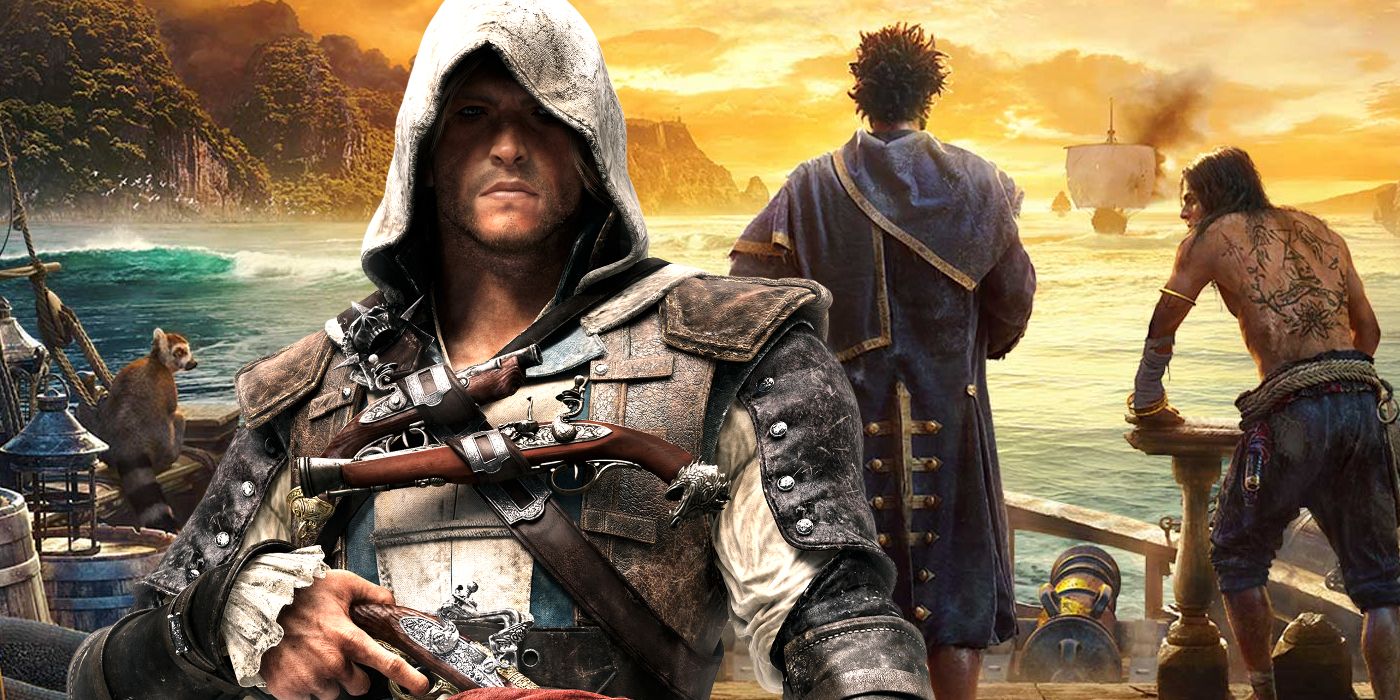Skull and Bones is Ubisoft’s upcoming pirate game, and a spiritual successor to Assassin’s Creed 4: Black Flag. Though the games’ concepts may be extremely similar on the surface, the new gameplay reveal for Skull and Bones showed that it’s strayed quite far from its predecessor. Fans of Black Flag who were looking forward to more of the same may be disappointed, but some might find the changes and additions to be welcome differences.
Ubisoft first announced Skull and Bones back in 2017, having already been in development for years at that point. The game was originally envisioned as an expansion to Black Flag itself, but it rapidly evolved into a fully-fledged spinoff game. Eventually, the decision was made to separate the game entirely from the Assassin’s Creed franchise and adapt it into an original property. As years passed and Skull and Bones‘ development went on, Assassin’s Creed fans became ever more eager for a follow-up to Black Flag. Since newer Assassin’s Creeds don’t have Black Flag‘s ship combat, even the franchise that originated the concept could no longer fulfill that fantasy. Now, with Skull and Bones set to release November 8, 2022 – almost a decade after beginning development – fans will finally be able to enjoy piracy once again.
There are similarities between Skull and Bones and Assassin’s Creed 4: Black Flag, but they are also substantially different. The most fundamental difference is that while Black Flag is a single-player game, Skull and Bones will be a live-service multiplayer game. This has altered the mechanics necessary to support it, and brings with it a number of inherent mechanical differences. The game’s combat and events were also balanced with co-op play in mind, making the baseline assumptions of the developers different from those of Black Flag. Despite its roots as a Black Flag spinoff, Skull and Bones‘ shift to a multiplayer-first philosophy firmly planted it on a separate foundation, meaning its gameplay will feel different to Black Flag‘s from the ground up.
Skull And Bones May Not Borrow Enough From AC Black Flag
Another major shift in the design of Skull and Bones comes from the fact that it isn’t weighed down by the legacy of the Assassin’s Creed franchise. If it had released as an expansion or spinoff as planned, it would likely include land-based exploration and combat in its open world, along with a more robust narrative tied to the lore of Assassin’s Creed, rather than the player-focused emergent narrative that seems to be at the center of Skull and Bones. As it stands, Skull and Bones includes no land gameplay at all, save for its social hub area, Sainte-Anne. While Black Flag‘s naval combat served a broader narrative and other mechanics, Skull and Bones‘ seafaring and swashbuckling is its core feature and its highest priority. This mechanical focus is theoretically a positive step, as the naval combat is less likely to be watered down by other features, but in this case it may have been sharpened to too fine a point.
The naval combat in Skull and Bones is both more complex and more restrictive than its predecessor, offering players a great amount of variety in terms of their options for equipment and styles of play, but it has also shaved away more of the extraneous parts of Assassin’s Creed‘s formula than were probably necessary. As mentioned before, there is no land-based exploration or combat in Skull and Bones, which is understandable given the game’s concept, but disappointing given how long it’s been in development. Beyond that, though, players can’t even walk around their own ships at sea. While sailing, players are locked to a first-person perspective, either behind the wheel of the ship or from the position of whichever weapon they’re firing when aiming is necessary. This makes navigation and combat feel far more confined and overwhelming compared to Black Flag, as a wider field of view helps players take in more of their surroundings.
As for the combat itself, Skull and Bones‘ systems are starkly different from those in Black Flag. Since there are no land-based mechanics, the raiding of powerful strongholds only goes so far as destroying targets from afar while objectives complete. Even missions that require stealing assets don’t involve the player stepping foot outside their vessel. Worst of all, Skull and Bones failed to plunder Black Flag‘s most iconic feature: boarding actions. Whether raiding rival ships or defending one’s own in the midst of combat, boarding actions brought life and flavor to the naval combat of Black Flag. Unfortunately, the lack of bipedal movement and personal equipment in Skull and Bones prevents the player from actively participating in such things. As shown in the gameplay reveal, boarding actions have been reduced to a short cutscene that plays mid-combat, a development that is sure to disappoint many.
Skull And Bones Restricts Some Features, But It Expands On Others
While many of Black Flag‘s best mechanics have been deprecated, Skull of Bones also offers a unique perspective on piracy that provides freedom where Black Flag didn’t. One of the benefits of decoupling the game from the baggage of Assassin’s Creed is that its narrative and characters are no longer obligated to be tied to the framework of the Animus, Assassins, and Templars. Assassin’s Creed 4 was beholden to Edward Kenway, its protagonist, as the lens for its story and gameplay, which offered a limited view of the vast world of piracy. In Skull and Bones, each player’s character can be customized individually, and their stories truly start from square one, which is a major contrast to Assassin’s Creed‘s protagonists. In Skull and Bones, players start with nothing more than a dinghy and a spear for self-defense, and they eventually work their way up to captaining a warship, which is a more expansive pirate fantasy than even Black Flag could offer.
In addition to customizing their character, Skull and Bones will have access to a fleet of options for personalizing their ships. Skull and Bones is set in piracy’s Golden Age, which is reflected in its extreme variety of ships and equipment. Some ships excel at combat, others are able to carry large amounts of cargo, and others still sail more swiftly than their contemporaries. For each ship, players can choose from wide selections of armor, weaponry, and other upgrades. Players will also have to keep their ships stocked with provisions in order to keep their crew healthy and in good spirits, as neglecting to do so could eventually result in a mutiny.
If players were expecting a direct sequel to Black Flag that exactly replicated its mechanics, they will be sorely disappointed by Skull and Bones. Whether the game can stand on its own merit, though, remains to be seen. Skull and Bones‘ long-awaited vision of the Golden Age of Piracy has its own identity, for better or worse, and could end up subverting many players’ expectations for the better.
About The Author


























































